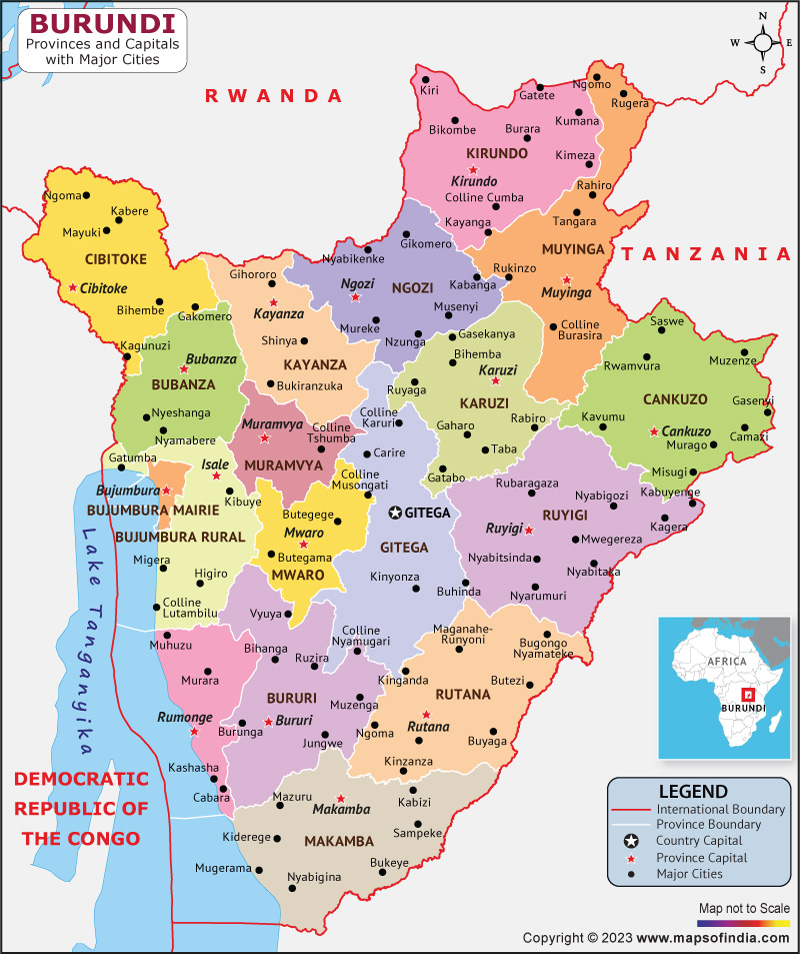East African landlocked nation of Burundi is bordered to the north by Rwanda, the east and south by Tanzania, and the west by the Democratic Republic of the Congo. The largest and capital city of Burundi is Bujumbura, which is situated in the southwest of the nation on the beaches of Lake Tanganyika. Burundi has a population of over 12,828,906 people and a total area of about 27,834 square kilometers. French and Kirundi are Burundi's official languages, although Swahili is also extensively used. Burundi, one of the smallest nations in Africa, has a vibrant cultural history, with traditional music, dance, and crafts playing a significant role in the nation's identity.
History:
Burundi's lengthy and complex history began in the 16th century with the establishment of the Tutsi monarchy. After World War I, Belgium took control of the area, which had been conquered by Germany in the late 19th century. Burundi became independent of Belgium in 1962, and a monarchy with the Tutsi king as the head of state was established. But in the decades that followed, tensions between the Tutsi and Hutu ethnic groupings led to a number of political upheavals and acts of violence, including the 1993 murder of the nation's first elected Hutu president. This incident launched a bloody civil war between the Hutu-led rebel groups and the Tutsi-led government, which raged until 2005 and claimed an estimated 300,000 lives. Since then, with the adoption of a new constitution in 2018 and the holding of free elections in 2020, Burundi has made some strides towards stability. Yet, the nation continues to struggle with issues including poverty, governmental corruption, and racial conflicts.
Culture:
Burundian culture is heavily influenced by the country's colonial history, as well as its ongoing struggle for political stability and economic development. Burundian culture places a high value on music and dance, and traditional instruments including drums, flutes, and stringed instruments are frequently employed in shows that include energizing, acrobatic dance routines. Burundian culture is renowned for its intricate basketry, which is frequently used in traditional events and as household goods, in addition to its music and dance. The utilization of regional ingredients including beans, plantains, and cassava, as well as a selection of meats and spices, define Burundian cuisine. Brightly coloured materials and patterns are common in Burundian traditional dress, and varied styles and patterns are used for various occasions.
Language:
Kirundi and French are Burundi's official languages. The majority of Burundians speak the Bantu language known as Kirundi, which is also spoken in nearby nations like Tanzania and the Democratic Republic of the Congo. French is the main language of instruction in secondary and postsecondary education, as well as in official government documents, business, and education. A sizable fraction of the population speaks Swahili in addition to Kirundi and French, especially in the eastern parts of the country close to the Tanzanian border.
Geography:
The country's landscape is made up of mountains and rolling hills; Mount Heha, the highest point, is 2,685 meters above sea level. Several sizable lakes may be found around the nation, including Lake Tanganyika, which forms a portion of Burundi's border with Tanzania. Burundi's weather is typically equatorial, with two wet and two dry seasons every year. Agriculture is the mainstay of the nation's economy, with coffee and tea being the two main cash crops. Burundi, despite having abundant natural resources and beauty, suffers a variety of environmental problems, such as deforestation, soil erosion, and land degradation.
| Official Name | Republic of Burundi |
| Capital | Gitega |
| Population | 12828906 |
| Area | 27,834 km2 |
| Currency | Burundian franc (BIF) |
| Religion | Christianity |
| Language | Kirundi and French |
| Major Cities | Bujumbura, Muyinga |
FAQs
Q1: What is the climate like in Burundi?
The climate in Burundi is generally equatorial, with two rainy seasons and two dry seasons each year.
Q2: What is the capital of Burundi?
Gitega is the capital city of Burundi.
Q3: What is the currency of Burundi?
Burundi’ s currency is the Russian ruble (RUB).
Q4: Which is the largest city of Burundi?
Bujumbura is the largest city in Burundi.
Last Updated on: June 05, 2025
